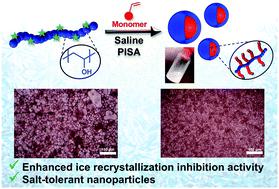当前位置:
X-MOL 学术
›
Mater. Horiz.
›
论文详情
Our official English website, www.x-mol.net, welcomes your
feedback! (Note: you will need to create a separate account there.)
Ice recrystallisation inhibiting polymer nano-objects via saline-tolerant polymerisation-induced self-assembly
Materials Horizons ( IF 12.2 ) Pub Date : 2020-05-14 , DOI: 10.1039/d0mh00354a Panagiotis G Georgiou 1 , Ioanna Kontopoulou 1 , Thomas R Congdon 1 , Matthew I Gibson 1, 2
Materials Horizons ( IF 12.2 ) Pub Date : 2020-05-14 , DOI: 10.1039/d0mh00354a Panagiotis G Georgiou 1 , Ioanna Kontopoulou 1 , Thomas R Congdon 1 , Matthew I Gibson 1, 2
Affiliation

|
Chemical tools to modulate ice formation/growth have great (bio)technological value, with ice binding/antifreeze proteins being exciting targets for biomimetic materials. Here we introduce polymer nanomaterials that are potent inhibitors of ice recrystallisation using polymerisation-induced self-assembly (PISA), employing a poly(vinyl alcohol) graft macromolecular chain transfer agent (macro-CTA). Crucially, engineering the core-forming block with diacetone acrylamide enabled PISA to be conducted in saline, whereas poly(2-hydroxypropyl methacrylate) cores led to coagulation. The most active particles inhibited ice growth as low as 0.5 mg mL−1, and were more active than the PVA stabiliser block alone, showing that the dense packing of this nanoparticle format enhanced activity. This provides a unique route towards colloids capable of modulating ice growth.
中文翻译:

通过耐盐水聚合诱导的自组装抑制聚合物纳米物体的冰重结晶
调节冰形成/生长的化学工具具有巨大的(生物)技术价值,冰结合/防冻蛋白是仿生材料令人兴奋的目标。在这里,我们介绍了聚合物纳米材料,它是使用聚合诱导自组装(PISA)并采用聚(乙烯醇)接枝大分子链转移剂(macro-CTA)的冰重结晶的有效抑制剂。至关重要的是,用双丙酮丙烯酰胺设计核心形成块使得 PISA 能够在盐水中进行,而聚(甲基丙烯酸 2-羟丙酯)核心则导致凝结。最活跃的颗粒抑制冰生长的量低至0.5 mg mL -1,并且比单独的PVA稳定剂块更活跃,表明这种纳米颗粒形式的致密堆积增强了活性。这为获得能够调节冰生长的胶体提供了一条独特的途径。
更新日期:2020-07-06
中文翻译:

通过耐盐水聚合诱导的自组装抑制聚合物纳米物体的冰重结晶
调节冰形成/生长的化学工具具有巨大的(生物)技术价值,冰结合/防冻蛋白是仿生材料令人兴奋的目标。在这里,我们介绍了聚合物纳米材料,它是使用聚合诱导自组装(PISA)并采用聚(乙烯醇)接枝大分子链转移剂(macro-CTA)的冰重结晶的有效抑制剂。至关重要的是,用双丙酮丙烯酰胺设计核心形成块使得 PISA 能够在盐水中进行,而聚(甲基丙烯酸 2-羟丙酯)核心则导致凝结。最活跃的颗粒抑制冰生长的量低至0.5 mg mL -1,并且比单独的PVA稳定剂块更活跃,表明这种纳米颗粒形式的致密堆积增强了活性。这为获得能够调节冰生长的胶体提供了一条独特的途径。











































 京公网安备 11010802027423号
京公网安备 11010802027423号